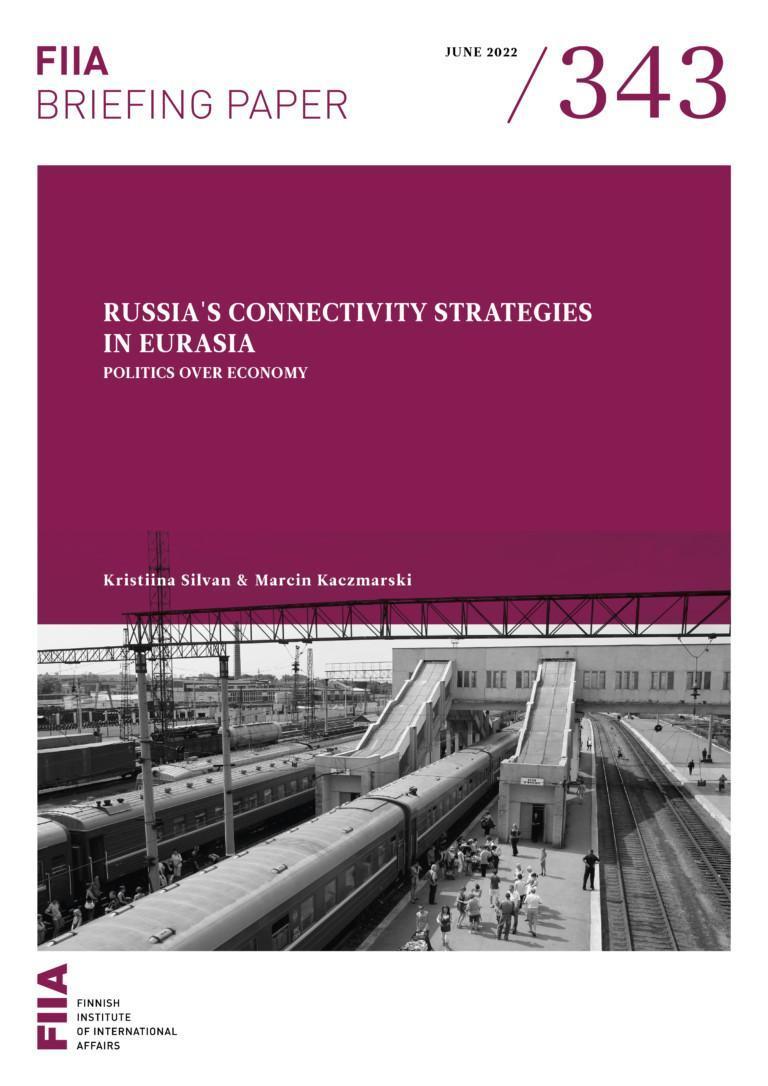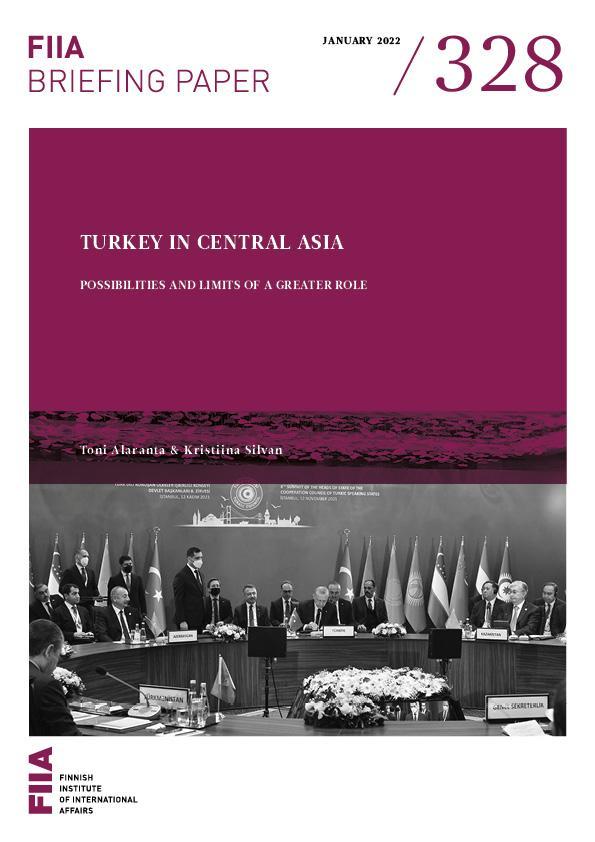
Russia has been attempting to strengthen connectivity within Eurasia since the early 2000s as a part of its policy to “pivot to the East”. Yet due to limited resources and political will, the tangible effects of its connectivity strategy have remained limited.
The Russian Far East would greatly benefit from an improved connectivity infrastructure, given its proximity to Asian markets and the abundance of natural resources in the region. However, the attempts to accelerate regional socio-economic development by strengthening the region’s connectivity have failed to make a difference.
In post-Soviet Central Asia, Russia adopted a passive approach to connectivity in the 1990s and 2000s, which meant focusing on maintaining and protecting the links inherited from the Soviet Union. It was only the pressure of external actors – both China and the West – that prompted Moscow to take a more active stance in the region in the 2010s.
The launch of China’s Belt and Road Initiative pushed Russia to promote its own grand vision of trans-continental connectivity, the Greater Eurasian Partnership, designed to reaffirm Moscow’s great-power status and its equal standing with China. While it lacks economic and administrative foundations and its implementation is highly implausible, it has fulfilled a symbolic role as Russia’s grand connectivity project for Eurasia.
Introduction
In the twenty-first century world, everyone talks about connectivity. Although the concept is rarely defined explicitly, a consensus has emerged that connectivity is about intentionally bringing countries, people, and societies closer together either by material or non-material means.[1] What is more, contemporary state and non-state actors are expected to be interested, in principle, in strengthening their connectivity with reliable partners, given that in a globalized world, being interconnected furthers development and modernization. In practice, connectivity promotion has driven the emergence and evolution of various connectivity strategies. In the sphere of infrastructure, global connectivity strategies fostered by national actors range from China’s Belt and Road Initiative (BRI) to the US Blue Dot Network and the European Union’s Global Gateway.
Russia has not been the most vocal participant in the debates about connectivity. Unlike China with the BRI, Russia does not pursue an internationally renowned grand strategy of connectivity. Nonetheless, Moscow has been aware of and concerned about the role of connectivity in the international system for decades. Given that the Russian economy depends on extracting and exporting natural resources like coal, gas, and oil to the global market, building and maintaining functional energy trade infrastructure has been in the Kremlin’s interest for a long time. After the disintegration of the Soviet Union, Moscow was forced to readjust its connectivity strategy given the emergence of new state borders between the Russian Federation and the fourteen other post-Soviet republics. Finally, Russia’s quest for a great-power status, the gradual worsening of its relations with the West, especially after the annexation of Crimea in 2014, as well as the rise of China and its promotion of the BRI have served as fertile ground for renewed connectivity considerations in the Russian Federation.
This Briefing Paper analyzes Russia’s approach to connectivity and its implications for domestic and foreign policy. It is situated in the debate on Russia’s declarative “pivot to Asia”, which underpins Moscow’s current Foreign Policy Concept, the document outlining Russia’s role and place in the world, last updated in 2016. In geographical terms, the paper focuses on Russia’s connectivity strategy in Central and Eastern Eurasia: in the Russian Far East (RFE), in Central Asia, and within the so-called Greater Eurasia. It argues that in each of these three spaces, Russia’s attempts to foster connectivity follow a somewhat different logic. Improving the connectivity of the RFE is a means for regional development, while fostering connectivity in post-Soviet Central Asia with the help of institutions like the Eurasian Economic Union is an attempt to slow down the erosion of the Soviet connectivity legacy. In turn, connectivity promoted in the framework of the Greater Eurasian Partnership is meant to ensure symbolic status equality with China and to counter US-promoted connectivity frames, such as the Indo-Pacific Region. With its focus on Asia, the paper does not cover Russia’s connectivity policy in the Arctic nor at its Western border.[2]
By contrasting Russia’s different connectivity policies in Asia, the Briefing Paper presents a twofold argument. First, although Moscow has no uniform strategy for connectivity, it is involved in the making of connectivity spaces by launching initiatives at home and abroad. Second, due to Russia’s limited resources and lack of political will, its connectivity practices reflect primarily political rather than economic reasoning. This is why the development effect on the ground remains limited. Russia’s ongoing war in Ukraine has only strengthened this trend.
Connectivity within Russia: Developing the Russian Far East
Russia’s Far Eastern Federal Okrug (district) is marginal in terms of its population (just 6 million), but it is significant both in size (encompassing 41% of Russia’s entire territory) and in natural resources like oil, gas, coal, and precious metals. It is also important from the security perspective, given its borders with China, Japan, Mongolia, and North Korea. However, the region has suffered from a lack of systematic engagement ever since the collapse of the Soviet Union. Despite the promising natural wealth, the connectivity infrastructure of the RFE is notoriously underdeveloped. For example, the local gas supply system is falling particularly short of its potential.[3]

Russian policymakers both in the Kremlin and in the region regularly voice concerns about the gap between the potential and current level of connectivity. During Dmitry Medvedev’s presidency (2008–2012), the RFE was envisioned as the gateway for Russia’s “pivot to the East”. One of the symbolic signs of the RFE’s elevated status and future development was the organization of the Asia-Pacific Economic Cooperation (APEC) summit in Vladivostok in 2012. However, there were no tangible and durable effects on the ground in the summit’s aftermath.
The discussion about the RFE’s modernization is also linked to debates about the relevance of Asia for Russia’s foreign policy. Following the gradual worsening of Russia’s relations with the West, particularly after the 2014 annexation of Crimea, Russia’s foreign policy has witnessed a reorientation towards Asia. In contrast to Russia’s 2013 Foreign Policy Concept, which made only passing reference to collaboration with Asian partners, the 2016 edition underlines Moscow’s desire for closer economic and political collaboration with the Asia-Pacific region. Asia-Pacific’s “dynamic integration” is portrayed as an opportunity for Russia to implement its own domestic programmes of socio-economic development in Siberia and the Far East.[4]
However, Russia’s “turn to the east” has not been translated into concrete results. It has not fuelled new growth in Russia’s economy nor supported a new development drive in the RFE. Moscow has not emerged as a fully-fledged participant in the East Asian regional order but has instead only been drawn into closer cooperation with China.[5] The RFE has not turned into the planned trade and investment hub connecting Asia with Russia (and Europe) on account of the region’s inadequate rail and sea transport infrastructure, and the inability to attract foreign investment to improve it.[6]
What is more, Russian leaders have, in fact, obstructed the establishment of closer links with Asia and halted investment into the RFE when it has been considered too costly politically. This has been particularly clear in terms of Russia’s relations with Japan. Since 2014, Japanese Prime Minister Abe Shinzo has attempted to gain concessions from Moscow on the issue of the disputed Kuril Islands by pursuing closer political ties and offering economic engagement. Drawing on Putin’s annual addresses, Tokyo offered to support Moscow in developing industries and export bases in the RFE. However, given that the status of the Kuril Islands remains non-negotiable for Moscow, especially given Japan’s dependence on the US for its security, it rejected Abe’s bargain and instead increased its political-military pressure on Tokyo.
Speaking in November 2021, President Vladimir Putin claimed that the development of the RFE would be Russia’s priority not just for years but for centuries to come. Indeed, improving the region’s road and airport connectivity infrastructure would serve an important social function and bring the domestic population together. However, the Kremlin has demonstrated that it prefers politically important projects over those of socio-economic value: for example, funds from a bridge-building project across the River Lena in Yakutsk were redirected in 2014 to support the construction of the Crimea Bridge in Ukraine. In effect, the decade-long de-prioritization of the RFE fuels popular alienation from Moscow. In 2020, the resentment towards the Kremlin triggered week-long protests against the removal of Khabarovsk’s popular governor, Sergei Furgal.
With the sanctions imposed on Russia after the 2022 invasion of Ukraine, an improvement in the RFE’s connectivity looks even less likely than before. South Korea and Taiwan have joined the “collective” Western front of sanctions against Russia. Japan, unwilling to sacrifice its functional relationship with Russia, has banned new investments but remains involved in the Sakhalin energy projects. All in all, sanctions will hamper the RFE’s ability to attract foreign investment and negatively affect Russian domestic aviation, thus generating further challenges for Russia’s domestic connectivity.
Connectivity with Central Asia: Maintaining the post-Soviet heritage
The break-up of the Soviet Union left the Russian Federation in a privileged position vis-à-vis its new neighbours in Central Asia. Each type of infrastructure – from railway to oil and gas pipelines – linked those states with Russia rather than with each other. This state of affairs prompted Russia to adopt a passive approach towards connectivity in Central Asia in the 1990s and early 2000s. Driven by the fear of both economic and geopolitical competition, Moscow sought to prevent the emergence of new infrastructural links, especially those that would bring natural resources from Central Asia to the European market. For years, Russia opposed such projects as the Nabucco gas pipeline, proposing new ideas for infrastructure itself. In 2007, Russia convinced Kazakhstan and Turkmenistan to agree on the construction of a new trans-Caspian gas pipeline that would bring additional Turkmenistani gas to Russia.
The agreement was never implemented, however. Instead, the Russian monopoly over connectivity infrastructure was gradually undermined, most consistently by China. Beijing began by opening a railway connection with Kazakhstan in the early 1990s. In the second half of the 2000s, China constructed an oil pipeline from Kazakhstan and a gas pipeline from Turkmenistan (via Uzbekistan and Kazakhstan). As a result, Russia lost its privileged position in the Central Asian energy sector. Moscow was only consoled by the fact that it was China rather than the EU that remade the region.
The Russian leadership decided to pursue a more active response in the aftermath of the global financial crisis of 2008. Drawing on the experience of past failures in establishing closer economic cooperation within the post-Soviet area, Russia chose to pursue integration in the narrowest possible format, with Belarus and Kazakhstan, starting with the Customs Union, and hoping to attract Ukraine. When Vladimir Putin reinvigorated the idea of the Eurasian Union (present in the post-Soviet discourse since the mid-1990s) in late 2011, Minsk and Nur-Sultan were again selected as the key partners. The Eurasian Union was supposed to revive Soviet-era ties, consolidate Russia’s position in the post-Soviet space and prevent further loss of influence in the region to China and the West.[7] If properly implemented, the Eurasian Union could have functioned as Russia’s grand connectivity project.
Russia’s ambitions have been scaled down since. First, the 2014 Revolution of Dignity in Ukraine nullified the already weak prospects of Ukraine participating in Russian integration projects. The war in 2022 has made this change irreversible. Second, acting in tandem after the Crimean annexation, Kazakhstan and Belarus forced Moscow to limit the scope of integration to the economic domain, which led to the establishment of the Eurasian Economic Union (EAEU).
The primacy of (geo)politics over (geo)economics continues to limit Russia’s prospects of successfully implementing its regional cooperation projects. Moscow seems to be interested in the instrumental use of the EAEU for its political purposes, such as elevating its great-power status, to the detriment of practical implementation. Protectionist impulses and the lack of adequate financial resources dissuade Russia from genuinely pursuing regional integration, which would incur serious costs alongside potential benefits. The most successful element appears to be the functioning labour market within the EAEU, which allows citizens of member states to work legally in Russia.
Beyond the (post-)Soviet: Connectivity in Eurasia and Asia-Pacific
Russia’s approach to connectivity beyond the boundaries of the former Soviet Union has been defined by two competing logics: practical and power-political. The practical and economically profitable logic dictated the use of Russia’s vast territory as a land bridge between flourishing Asian economies and their counterparts in Europe. The power-political logic implied the use of connectivity as an instrument of great-power politics and status-seeking. Whereas this type of thinking can be traced back to the ideas of the ‘Greater Europe’ of the early 1990s, the emphasis on Eurasia was ‘forced’ upon Moscow by growing activities in the connectivity realm of its peers, particularly China.
The ideas of Russia playing a major role in linking Asian and European markets have been centred around the revival of the Trans-Siberian Railway (TSR) and railway freight. This route was originally employed by Japan for shipping containers to Europe and the Middle East from the 1970s onwards, but it lost its popularity towards the early 1990s. South Korean companies partially replaced their Japanese counterparts, but the so-called Siberian Land Bridge continued to lose to competitive pricing of maritime routes. The route experienced a partial revival in the 2000s, but this time it was China – and its north-eastern provinces – that dominated the transit with 70% of containers, followed by South Korea (20%) and Japan (almost 10%).[8]
Russia’s situation and prospects changed in the early 2010s when China began opening railway connections with the European Union states. The majority of those connections operate on Russian territory and employ the western part of the Trans-Siberian Railway, with the entry point for transit on the Kazakhstan-Russia border. In the post-Soviet space, the route is operated by the joint Kazakhstani-Russian-Belarusian railway company, United Transport and Logistics Company (UTLC). In 2021, as many as 15,000 trains used the China-EU railway route carrying almost 1.5 million TEUs.[9] As a result, the Chinese initiative has become a direct competitor for the Russian-led freight from Vladivostok. Additionally, the route from China to Kazakhstan generates competition for the Central Asian markets, which can now be accessed using both the Trans-Siberian Railway and the route from China. The establishment of the regular railway connection between China and Europe was mostly driven by the commercial interests of economic actors, including stakeholders from Russia (Russian Railways, RZD), with the governments playing a secondary role.[10] This fact sheds light on the inconsistency of Russian policy in the sphere of connectivity.
China’s Belt and Road Initiative (BRI), launched in 2013, has become an even bigger political challenge for Russia. The project was a gigantic leap in geopolitical and geoeconomic imagination, transcending traditional political boundaries. While not aiming explicitly to bypass Russia, the BRI put China in the position of an ‘organizer’ of the Eurasian space. Beijing’s project gained almost global recognition and became the trademark of both a risen China and its leader, Xi Jinping.
The power-political dimension seems to have preoccupied the Russian elite much more than the search for practical solutions to growing competition from corridors established by China and from maritime transport. As a result, Moscow responded to the BRI by proposing the Greater Eurasian Partnership. In its grandiose scale, the Russian initiative envisions a network of connections between key Asian powers – Russia, China, India – and regional organizations, from the Shanghai Cooperation Organisation (SCO) and the BRI to ASEAN. Although Moscow portrays Greater Eurasia as a comprehensive connectivity project, it does not seem to be interested in its practical implementation, and nor does it have the financial and administrative capacity to pursue such an idea.
In comparison, both the BRI and Greater Eurasia remain ill-defined. The BRI functions as an umbrella term for China-led bilateral cooperation with a number of states around the world. However, given the financial resources at Beijing’s disposal, China’s project still looks more feasible than its Russian counterpart. Moreover, Russia’s war in Ukraine has seriously weakened Moscow’s position in North-East Asia. Japan and South Korea joined the Western sanctions, which may have a negative effect on the use of the Trans-Siberian corridor. A prolonged conflict and the increasing scope of sanctions against Russia may lead to a complete shutdown of the railway transport from Russia (especially given the role of the Russian Railways, RZD, in controlling the railway route via Russia). The war will also accelerate the preparation of to-date less profitable railway routes such as those via South Caucasus states and Turkey.
Conclusions
Since the launch of China’s Belt and Road Initiative, policymakers around the world have rushed to formulate their own strategies and practical projects for enhancing connectivity. Russia, considering itself a great power and one of the nodes of the emerging multipolar world order, has been no exception. Yet there are notable differences in how connectivity is understood as a concept and applied in practice, as a closer look at the US Blue Dot Network and the EU’s Global Gateway project demonstrates.
Moscow’s connectivity strategy is characterized by its fluidity. In the domestic context of the underdeveloped yet resource-rich Russian Far East, the aim of strengthening connectivity is to increase trade and investment in order to foster regional development. In Central Asia, Russia’s connectivity strategy seeks to preserve and further develop Soviet-era infrastructure, whereas in Eurasia beyond the former USSR, the rationale for enhancing connectivity is to increase the interaction between the continent’s states and international organizations under Moscow’s watch. Although these three incarnations of Russia’s connectivity strategy are interlinked with one another, their differences demonstrate that Moscow has no unitary and clearly defined approach to connectivity.
Whereas the BRI has challenged Russia’s role in Eurasia and generated competition with China, both Moscow and Beijing have attempted to limit the scope of this competition. In practical terms, Chinese actors need to cooperate with their Russian counterparts, given that the easiest railway route leads through the Russian territory. Politically, Beijing has recognized the Greater Eurasian Partnership as equal to the BRI, thus reaffirming its acceptance of Russia’s claim to the status of a great power.
Despite the fluidity of Moscow’s connectivity strategy, there is one core characteristic that applies to all of its forms: the primacy of (power) political logic over a practical economic rationale. Given issues ranging from rampant corruption to weak institutions, administrative ineptitude, and its state of underdevelopment, Russia does not foster connectivity for financial advantages, nor in order to support domestic businesses. Instead, its aim is to be seen as a great power – whether at home or abroad. Consequently, China and other actors might be better placed to make a tangible impact in enhancing connectivity on the ground.
Endnotes
[1] Kacperek, Marcin (2020) ‘(Re)defining connectivity’, Warsaw Institute Opinions, 21 October 2020, https://warsawinstitute.org/redefining-connectivity/. [All links were last accessed on 7 June 2022.]
[2] On Russia’s Northern Sea Route, see e.g. Blakkisrud, Helge (2021) ‘The Impact of Domestic Politics on Russia’s Arctic Agenda’. In Nordic-Baltic Connectivity with Asia via the Arctic: Assessing Opportunities and Risks, edited by Bart Gaens, Frank Jüris & Kristi Raik. Tallinn: International Centre for Defence and Security, 70-88.
[3] Ferris, Emily & Connolly, Richard (2020) ‘Networks and Links: Why Russia’s Infrastructure is Holding Back its Pivot to Asia’, Research Paper, July 2020, Chatham House, https://www.chathamhouse.org/sites/default/files/2020-07-27-networks-links-russias-infrastructure-ferris-connolly.pdf.
[4] ‘Kontseptsiia vneshnoi politiki Rossiiskoi Federatsii’ [Foreign Policy Concept of the Russian Federation], confirmed by the Decree of the President No. 640, 30 November 2016, https://docs.cntd.ru/document/420384312#6520IM, point 78.
[5] Kaczmarski, Marcin (2020) ‘Russian-Chinese Relations and Russia’s Turn to Asia’. Acta Slavica Iaponica 41: 111-123.
[6] Ferris & Connolly, ‘Networks and Links’.
[7] Roberts, Sean; Marin, Anaïs; Moshes, Arkady & Pynnöniemi, Katri (2015) ‘The Eurasian Economic Union: Breaking the pattern of post-Soviet integration?’, FIIA Analysis 3, https://fiia.fi/wp-content/uploads/2017/01/a3.pdf.
[8] Tsuji, Hisako (2013) ‘Competitive Advantages and Disadvantages of Trans-Siberian Railway Route: Case study of Korea and Japan’, International Journal of Railway 6 (4): 139-147; see also Tsuji, Hisako (2002) ‘Japan and the ROK’s Involvement in International Container Transportation Using the Trans-Siberian Railway’, Erina Report Vol. 46.
[9] Clinnick, Richard (2022) ‘Ukraine Invasion Impacts Asia-Europe Freight Flows’, Analysis, International Railway Journal, 25 March 2022, https://www.railjournal.com/analysis/ukraine-invasion-impacts-asia-europe-freight-flows/.
[10] Pomfret, Richard (2019) ‘The Eurasian Landbridge and China's Belt and Road Initiative: Demand, supply of services and public policy’, The World Economy 42, 1642–1653. See also Tjia, Yin-nor Linda (2020) ‘The Unintended Consequences of Politicization of the Belt and Road’s China-Europe Freight Train Initiative’, The China Journal 83; Bucsky, Péter (2020) ‘The iron Silk Road: how important is it?’, Area Development and Policy, 5(2), 146-166.







